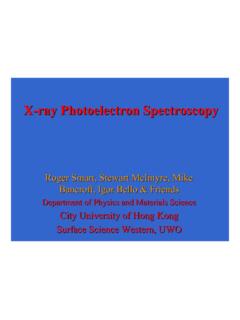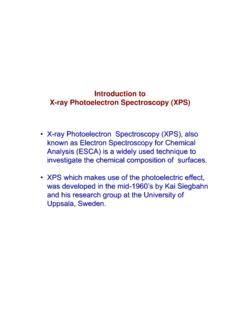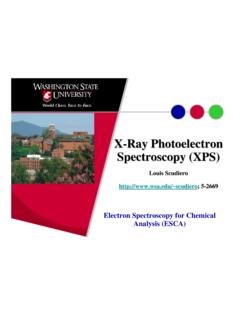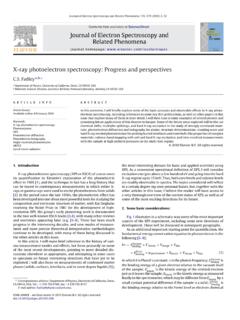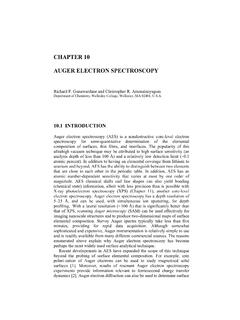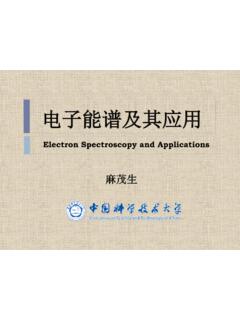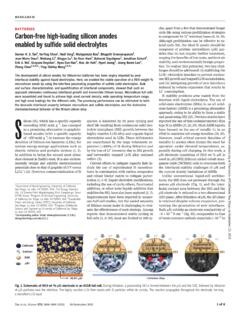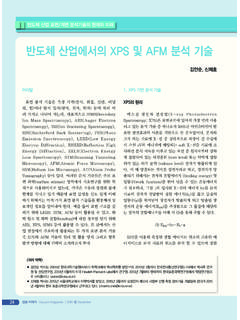Search results with tag "Ray photoelectron spectroscopy"
X-Ray Photoelectron Spectroscopy (XPS/ESCA)
images.philips.comMar 02, 2017 · X-Ray Photoelectron Spectroscopy (XPS/ESCA) XPS (X-ray Photoelectron Spectroscopy) or ESCA (Electron Spectroscopy for Chemical Analysis) is based on the principle that X-rays hitting atoms generate photoelectrons. It is a typical example of a surface-sensitive technique. Only electrons that are generated in the top few atomic layers are detected.
X-ray Photoelectron Spectroscopy
mmrc.caltech.eduXPS X-ray Photoelectron Spectroscopy ESCA Electron Spectroscopy for Chemical Analysis UPS Ultraviolet Photoelectron Spectroscopy PES Photoemission Spectroscopy XPS, also known as ESCA, is the most widely used surface analysis technique because of its relative simplicity in use and data interpretation.
Introduction to X-ray Photoelectron Spectroscopy (XPS)
pire-ecci.ucsb.eduX-ray Photoelectron Spectroscopy (XPS) • X-ray Photoelectron Spectroscopy (XPS), also known as Electron Spectroscopy for Chemical Analysis (ESCA) is a widely used technique to investigate the chemical composition of surfaces. • XPS which makes use of the photoelectric effect, was developed in the mid-1960’s by Kai Siegbahn
X-Ray Photoelectron Spectroscopy (XPS)
public.wsu.edu• X-ray Photoelectron Spectroscopy (XPS or ESCA) - using soft x-ray (200 - 1500 eV) radiation to examine core-levels. • Ultraviolet Photoelectron Spectroscopy (UPS) - using vacuum UV (10 - 45 eV) radiation to examine valence levels. • Auger Electron Spectroscopy(AES or SAM) – using energetic electron (1000 – 10,000 eV) to examine core ...
Modulating the local coordination environment of single ...
link.springer.comcatalysts with supported metal atoms or nanoparticles, the X-ray derived spectroscopies (include X-ray photoelectron spectroscopy (XPS), X-ray absorption near edge spectroscopy (XANES) and extended X-ray absorption fine structure (EXAFS) spectroscopy techniques) are most essential approaches to characterize their coordination environments.
X-ray Photoelectron Spectroscopy (XPS)
www.ru.ac.zaX-ray Photoelectron Spectroscopy (XPS) Contents WHAT is XPS? HOW does it work? An in-depth look at each component of the instrument WHERE can this ... via mapping or depth profiling • Binding energy is measured giving information on the origin of the photoelectron. HOW does this instrument work? Applications: Elemental composition in wide scans.
X-ray Photoelectron Spectroscopy
assets.thermofisher.comXray photoelectron spectroscopy (XPS) is one of the foremost tools for studying this surface chemistry. In its simplest form, XPS involves shining Xrays onto a material to knock electrons from the surface atoms. By counting these ejected electrons and measuring their energy, it is possible to
X-ray photoelectron spectroscopy: Progress and perspectives
fadley.physics.ucdavis.eduC.S. Fadley / Journal of Electron Spectroscopy and Related Phenomena 178–179 (2010) 2–32 3 Fig. 1. Illustration of a typical experimental configuration for X-ray photoelectron spectroscopy experiments, together with the various types of measurements possible,
CHAPTER 10 AUGER ELECTRON SPECTROSCOPY
www.wellesley.eduX-ray photoelectron spectroscopy (XPS) (Chapter 11), another core-level electron spectroscopy. Auger electron spectroscopy has a depth resolution of ... angle-resolved Auger electron spectroscopy can provide a means to study excitation processes in solids [4]. The Auger process is a three-electron process. When a beam of electrons,
X射线光电子能谱学》 - USTC
staff.ustc.edu.cnVolume 1: Auger and X-ray Photoelectron Spectroscopy”, John Wiley & Sons, 1992 4. Stefan Hüfner, “Photoelectron Spectroscopy: Principles and Applications”, Springer-Verlag, 2003, ISBN: 3-540-41802-4 5. Graham C. Smith, “Surface Analysis by Electron Spectroscopy: Measurement & Interpretation”, Plenum Press, New York, 1994 6.
Investigation of multiplet splitting of Fe 2p XPS spectra ...
www.surfacesciencewestern.comX-ray photoelectron spectroscopy has become a highly surface-sensitive technique that has found use in many different areas of chemistry. The effects of chemical changes on the photoelectron peak shape have been of particular interest. For studies involving iron, the 2p 3/2 peak for high-spin Fe3 Cand Fe2 compounds is broadened compared with
电子能谱及其应用 - USTC
staff.ustc.edu.cnVolume 1: Auger and X-ray Photoelectron Spectroscopy”, John Wiley & Sons, 1996 4. Graham C. Smith, “Surface Analysis by Electron Spectroscopy: Measurement & Interpretation”, Plenum Press, New York, 1994 5. 吴正龙译《表面分析(XPS和AES) 引论》华东理工大学出版社,2008 6.
3 Espectroscopías electrónicas - UAH
edejesus.web.uah.esXPS, UPS y V-UV. • Niveles interiores. Para arrancar electrones de niveles interiores es necesario utilizar una radiación de mayor energía (entre 50 y 1200 eV), lo que se corresponde con la zona de los rayos X, por lo que la técnica recibe el nombre de XPS (X-Ray Photoelectron Spectroscopy). Recordemos que las
X線光電子分光法(XPS)の紹介 - ENEOS
www.eneos.co.jp分光法(XPS:X-ray Photoelectron Spectroscopy)は、 固体表面を分析する表面分析手法の一つであり、ESCA (Electron Spectroscopy for Chemical Analysis)と呼ば れることもある。 XPSの分析対象は広く、金属、無機および有機、材料
X線光電子分光法(XPS)の原理と応用 - JAIMA
www.jaima.or.jp法として広く普及しています。X線光電子分光法 はXPS(X-ray Photoelectron Spectroscopy)の 名称だけでなく、ESCA(Electron Spectroscopy for Chemical Analysis)の呼び名で1970年代以 降広く知られています。 XPSは励起源として軟X線を用いているため、
CHAPTER 1: CLASSIFICATION OF MATERIALS
www.uwosh.eduhard but malleable stiff or flexible hard but brittle shiny dull shiny if glazed little color colorless many colors ... X-Ray Photoelectron Spectroscopy (XPS), is described in Chapter 14. It is most often used to test metals and ceramics. 1 - 8 As shown in the figure, different sets of elements are found in metal, polymer and
Carbon-free high-loading silicon anodes enabled by sulfide ...
smeng.ucsd.eduThese observations agree with the x-ray photoelectron spectroscopy (XPS) analysis in Fig. 2C, where the presence of carbon results in a greater extent of SSE decomposition, as seen by the formation of Li 2S(161eV)intheS 2p region. Consequently, a larger decrease in peak intensities for the PS 4 3− thiophosphate ...
반도체 산업에서의 XPS 및 AFM 분석 기술
www.kvs.or.kr엑스선 광전자 분광법(X-ray Photoelectron Spectroscopy; XPS)은 표면분석에 있어서 가장 널리 사용 되고 있는 분석 기술 중 하나로서 1905년 아인슈타인이 발 표한 광전효과의 이론을 기반으로 한 분석법이다. 분석하 고자 하는 시료에 X-선 중 상대적으로 파장이 긴 수십에
XPS - ccn.yamanashi.ac.jp
www.ccn.yamanashi.ac.jpXPSの基礎理論と応用例 ~ユーザーの立場から~ 近藤英一 H15.3.11 地域共同研究センター高度技術研修 XPS • X-ray photoelectron spectroscopy
CHAPTER 1: CLASSIFICATION OF MATERIALS
www.uwosh.edu1.1 WHY STUDY MATERIALS? On a sunny day at the park, where would you prefer to sit and relax - on a wooden bench, ... height Volume = length x width x height. 1 - 6 5 mL ... in a sample. One of the most sophisticated techniques, X-Ray Photoelectron Spectroscopy (XPS), is described in Chapter 14. It is most often used to test metals and ceramics.
Similar queries
X-Ray Photoelectron Spectroscopy XPS/ESCA, Ray Photoelectron Spectroscopy, ESCA, Spectroscopy, Photoelectron Spectroscopy, Modulating the local coordination environment of single, Photoelectron, Electron Spectroscopy, CHAPTER 10 AUGER ELECTRON SPECTROSCOPY, Angle, Resolved, X射线光电子能谱学, Hard, CHAPTER 1: CLASSIFICATION OF MATERIALS, STUDY

